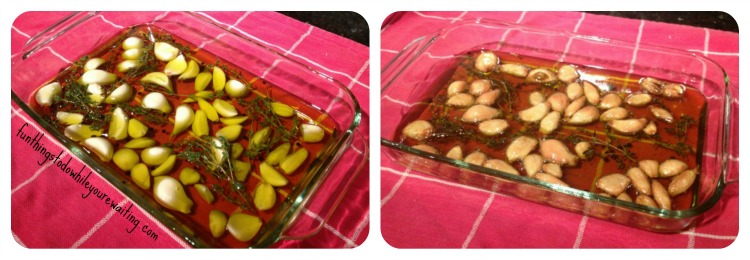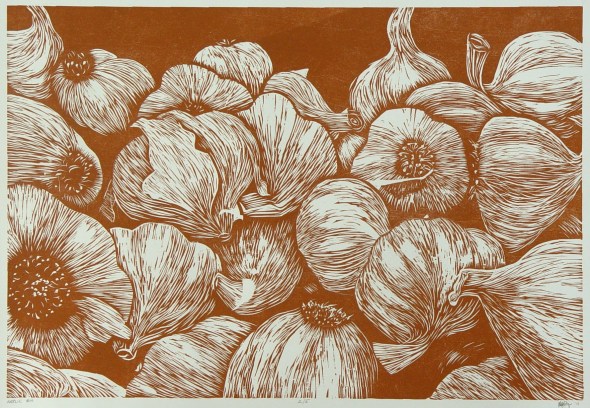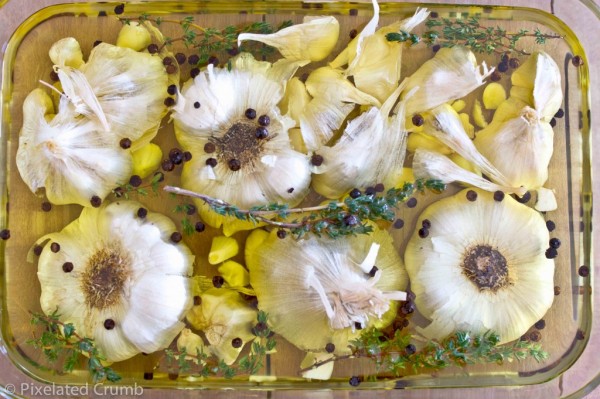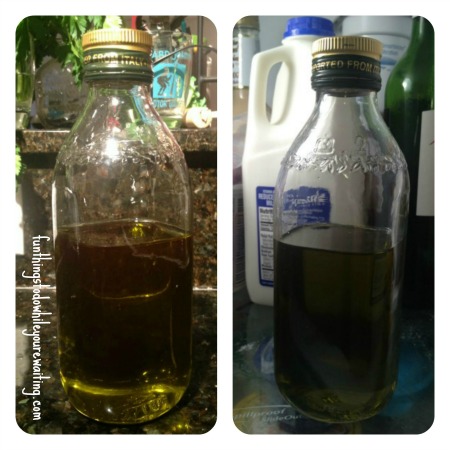Does anyone NOT love garlic? Seriously. Anyone? Only once have I uttered the phrase, “mmm… there’s too much garlic in this…” There is a standing rule in my household that states: if a recipe calls for garlic (unless its raw), double it. So, making your own garlic olive oil seemed like the logical next step in my ongoing love affair with garlic. I always just imagined that it was as easy as throwing fresh garlic cloves into a bottle, adding olive oil, and then waiting. Oh, no ma’am. I mean, technically, YES… you can put some fresh garlic cloves in a bottle of olive oil and wait… these are things you CAN do… but you shouldn’t. If you do a simple search of “Make Your Own Garlic Olive Oil” in Google, you’ll start to notice the word “botulism” floating around your results. Yeah. Botulism.
In researching this post, I fell into a deep rabbit hole on the internet of science, germ-conspiracy, speculation, and heated debate. So, basically, another day on the internet. Although olive oil is an anaerobic environment and allows no bacterial growth… when you let something that once grew somewhere and has even a trace amount of water* (see comments) sit in room-temperature olive oil for even a few hours, then you are introducing the possibility of botulism. There is a solid camp on the internet that says the chance of you getting botulism in this manner is super slim, but do you really want to take that chance? Even with slim odds? The FDA has even passed laws that any commercially produced garlic olive oils must now have a citric/phosphoric acid component to prevent the growth of botulism-causing bacteria and must be kept refrigerated after opening. So, I started researching a safer way to get the garlic taste into olive oil without potentially killing myself.
Apparently, if you roast the garlic IN the oil (raising it to a sufficient temperature) and then REMOVE the garlic before storing the oil, then it becomes okay. You still need to refrigerate it immediately and use it within a few weeks, but after I figured out a way to circumvent possibly dying of botulism, I immediately began imagining all the things I could make with roasted garlic infused olive oil.
I found a beautiful post over on Pixelated Crumb that I used as a guideline. I mean, look at this beautiful picture!
We had already peeled the garlic, so instead of cutting the garlic in half as this recipe suggests, we just went with ours as they were. We put the peeled garlic in a glass casserole dish and covered with olive oil, fresh thyme, and peppercorns. We baked this at 350 degrees for 45 minutes. Below is the before and after of the roasting process. Look how beautiful and yummy it looks; all brown and roasty.
 Let the dish cool and then drain oil to remove thyme, garlic, and peppercorns. We have a great measuring cup that is also a fat separator, but any sieve/colander will do.
Let the dish cool and then drain oil to remove thyme, garlic, and peppercorns. We have a great measuring cup that is also a fat separator, but any sieve/colander will do.
Once you have it all filtered, pour oil into a bottle (I had saved and washed an empty olive oil bottle in preparation for this project) and refrigerate.
So, not only do you now have awesome flavor-infused olive oil, but you also have a ton of super yummy roasted garlic. I, personally, spread some roasted garlic on some toast and it was amazing. Will I do this again? Maybe. Almost all of the boards on the internet pages about this topic agreed that the best course of action is to make your garlic-infused olive oil in small batches and eat them immediately- whether you use roasted or raw. That way you don’t even take the risk and you just toss the extras. So, take all of this for what its worth… and let me know what you think. Is the concern over botulism hooey? Would you risk it? Is this something of which you’ve heard?









Leigh, this looks awesome! Botulism is NO JOKE! And I think the typical consumer is unaware how often the risk is present (even if small). For instance- in home canned stuff & even commercially canned stuff when the can is dented- I think y’all did the right thing. Wish I was eating toast w you!
“when you let something that once grew somewhere and has even a trace amount of water sit in room-temperature olive oil for even a few hours, then you are introducing the possibility of botulism.”
Most of this post is spot on, but to be clear, water has nothing to do with botulism toxin in garlic infused oil.
Clostridium botulinum spores are found in soil and consequently in legumes, garlic, root vegetables, etc. These spores germinate and release toxin in an anaerobic environment, like olive oil. The risk of botulism comes from the presence of CB spores and the perfect, oxygen-free germination environment created by storing the spores in olive and at room temperature.
Like you said though: make small batches, store in the fridge, and use within a week.
Monique-
Thanks for the great info! I am no scientithmician and love knowing people who can teach me stuff! Again, thanks for settin’ me straight and thanks for reading!